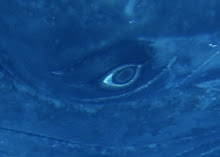This is a synopsis of the most recent email report I’ve received from Carlos. BlueVoice has funded his return to Chiclayo to begin a new recon of the area he and I covered two weeks ago.
On Saturday, the President of the Congress told all media that the Ministers of Production, Environment and Energy should present an explanation to the Congress plenary session regarding the dead dolphins in the north.
On Sunday, the Minister of Production (including fisheries) called me from his assistant’s cellphone. He wanted me in a personal meeting Monday morning
9am to talk on "environmental affairs".
Carlos and Elena gave him a summary of what they knew. He was very concerned. Carlos: “I just told him
we had evidence of the acoustic impact and we are researching possible diseases associated with the strandings, since we never recorded anything like this over the past decade. He asked bout the importance
of marine mammals, and why the dolphins are so important. We explained. He was impressed, and worried. He concurred with us that dolphins are to people psychologically the closest animal.
So, in summary, we requested three things and he agreed:
1. To support and to participate in education campaigns for dolphins and ocean health.
2. To enhance the participation of Peru against whaling.
3. To declare marine mammals,specially dolphins, of National Importance.
So, at the end of the meeting, he agreed that he would like to have a copy of our final report on the dolphin strandings
Tuesday, April 10, 2012
Friday, April 6, 2012
Detailed Report From Peru Dolphin Mortality Event
Here are some results from Dr. Carlos Yaipen Llanos's tests on dolphins washed up on Peruvian beaches. These tests were undertaken by ORCA - Peru and funded by BlueVoice. Additional results will be published here shortly.
As previously reported, two species have been affected: Long beaked
common dolphin (Delphinus capensis) and Burmeister’s porpoise (Phocoena
spinipinnis). We counted 615 common dolphins. All age classes were
affected: Adult males, females, lactating females, juveniles, calves and
newborns. We counted 19 porpoises, only females and calves.
There are carcasses in different degrees of decomposition and every 10
to 30 meters, none of them older than 5 weeks. This matches with the fact
that these strandings happened right after our previous survey. We found
animals recently dead (no more than 12 hours) and several carcasses of
juveniles and calves showed “rigor mortis” as being dead on land, then
stranded alive (stiff arc position, beak open, belly down, transversal to
tide line, no more than 3 days dead).
Necropsies were performed on site. Macroscopic findings include:
hemorrhagic lesions in the middle including the acoustic chamber,
fractures in the periotic bones, bubbles in blood filling liver and
kidneys (animals were diving, so the main organs were congested), lesions
in the lungs compatible with pulmonary emphysema, sponge-like liver. So
far we have 12 periotic samples from different animals, all with different
degree of fractures and 80% of them with fracture in the right periotic
bones, compatible with acoustic impact and decompression syndrome.
As previously reported, two species have been affected: Long beaked
common dolphin (Delphinus capensis) and Burmeister’s porpoise (Phocoena
spinipinnis). We counted 615 common dolphins. All age classes were
affected: Adult males, females, lactating females, juveniles, calves and
newborns. We counted 19 porpoises, only females and calves.
There are carcasses in different degrees of decomposition and every 10
to 30 meters, none of them older than 5 weeks. This matches with the fact
that these strandings happened right after our previous survey. We found
animals recently dead (no more than 12 hours) and several carcasses of
juveniles and calves showed “rigor mortis” as being dead on land, then
stranded alive (stiff arc position, beak open, belly down, transversal to
tide line, no more than 3 days dead).
Necropsies were performed on site. Macroscopic findings include:
hemorrhagic lesions in the middle including the acoustic chamber,
fractures in the periotic bones, bubbles in blood filling liver and
kidneys (animals were diving, so the main organs were congested), lesions
in the lungs compatible with pulmonary emphysema, sponge-like liver. So
far we have 12 periotic samples from different animals, all with different
degree of fractures and 80% of them with fracture in the right periotic
bones, compatible with acoustic impact and decompression syndrome.
Subscribe to:
Comments (Atom)
